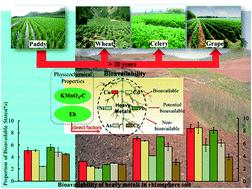当前位置:
X-MOL 学术
›
Environ. Sci.: Processes Impacts
›
论文详情
Our official English website, www.x-mol.net, welcomes your
feedback! (Note: you will need to create a separate account there.)
Divergent response of heavy metal bioavailability in soil rhizosphere to agricultural land use change from paddy fields to various drylands
Environmental Science: Processes & Impacts ( IF 4.3 ) Pub Date : 2021-2-19 , DOI: 10.1039/d0em00501k Yujuan Gao 1, 2, 3, 4, 5 , Jianli Jia 5, 6, 7, 8 , Beidou Xi 1, 2, 3, 4, 5 , Dongyu Cui 1, 2, 3, 4, 5 , Wenbing Tan 1, 2, 3, 4, 5
Environmental Science: Processes & Impacts ( IF 4.3 ) Pub Date : 2021-2-19 , DOI: 10.1039/d0em00501k Yujuan Gao 1, 2, 3, 4, 5 , Jianli Jia 5, 6, 7, 8 , Beidou Xi 1, 2, 3, 4, 5 , Dongyu Cui 1, 2, 3, 4, 5 , Wenbing Tan 1, 2, 3, 4, 5
Affiliation

|
The heavy metal pollution induced by agricultural land use change has attracted great attention. In this study, the divergent response of the bioavailability of heavy metals in rhizosphere soil to different agricultural land uses was analyzed using sequential extraction, and possible influence paths were constructed. The results show that land use change can affect the heavy metal bioavailability by influencing the soil organic matter and redox potential (Eh). The average concentrations of N, P, K, Ca, Mg, S, and Fe in the soil showed no significant differences. However, the conversion direction and extent of chemical speciation of heavy metals were different across land use changes from paddy fields to various drylands. After conversion from paddy to wheat field, the bioavailability of heavy metals decreased due to an increase in permanganate oxidizable carbon (KMnO4–C) and a decrease in Eh. The transformation from paddy to celery soil is accompanied by a change in the soil's KMnO4–C content, increasing the proportion of the bioavailable states of heavy metals. However, the response of bioavailability to changes in the soil KMnO4–C varied among heavy metals. In contrast, when land use changed to grapevine culture, the bioavailability of heavy metals increased due to a change in the KMnO4–C content. Moreover, the dissolved organic carbon (DOC) content increased, which positively affected the Eh and, in turn, increased the bioavailability of heavy metals. This research is of great significance for understanding the impact of land use change on the heavy metal migration and activity in the rhizosphere microenvironment of soil.
中文翻译:

从水田到各种旱地土壤根际重金属生物利用度对农业土地利用的不同响应
农业土地利用变化引起的重金属污染引起了人们的广泛关注。在这项研究中,通过顺序提取分析了根际土壤中重金属的生物利用度对不同农业土地利用的不同响应,并构建了可能的影响路径。结果表明,土地利用变化可通过影响土壤有机质和氧化还原电位(Eh)来影响重金属的生物利用度。土壤中氮,磷,钾,钙,镁,硫和铁的平均浓度无显着差异。但是,从稻田到各种旱地的土地利用变化,重金属的转化方向和化学形态的范围是不同的。从稻田改成麦田后,4 –C)和Eh的降低。从水稻土到芹菜土的转变伴随着土壤中KMnO 4 -C含量的变化,从而增加了重金属生物利用态的比例。然而,生物有效性对土壤KMnO 4 -C变化的反应在重金属之间有所不同。相反,当土地用途改为葡萄栽培时,由于KMnO 4的变化,重金属的生物利用度增加了。–C内容。此外,溶解有机碳(DOC)含量增加,对Eh有积极影响,进而增加了重金属的生物利用度。这项研究对于了解土地利用变化对土壤根际微环境中重金属迁移和活性的影响具有重要意义。
更新日期:2021-03-02
中文翻译:

从水田到各种旱地土壤根际重金属生物利用度对农业土地利用的不同响应
农业土地利用变化引起的重金属污染引起了人们的广泛关注。在这项研究中,通过顺序提取分析了根际土壤中重金属的生物利用度对不同农业土地利用的不同响应,并构建了可能的影响路径。结果表明,土地利用变化可通过影响土壤有机质和氧化还原电位(Eh)来影响重金属的生物利用度。土壤中氮,磷,钾,钙,镁,硫和铁的平均浓度无显着差异。但是,从稻田到各种旱地的土地利用变化,重金属的转化方向和化学形态的范围是不同的。从稻田改成麦田后,4 –C)和Eh的降低。从水稻土到芹菜土的转变伴随着土壤中KMnO 4 -C含量的变化,从而增加了重金属生物利用态的比例。然而,生物有效性对土壤KMnO 4 -C变化的反应在重金属之间有所不同。相反,当土地用途改为葡萄栽培时,由于KMnO 4的变化,重金属的生物利用度增加了。–C内容。此外,溶解有机碳(DOC)含量增加,对Eh有积极影响,进而增加了重金属的生物利用度。这项研究对于了解土地利用变化对土壤根际微环境中重金属迁移和活性的影响具有重要意义。











































 京公网安备 11010802027423号
京公网安备 11010802027423号